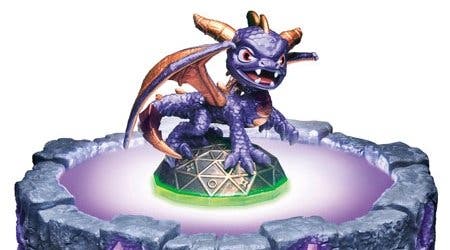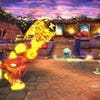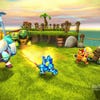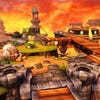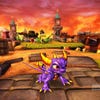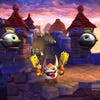Skylanders: Spyro's Adventure Review
Toy stories.
I have a very vivid memory from early childhood. I'm six or seven years old, sprawled out on the upstairs landing. The summer sunshine is dappling through the window, as it so often does in rose-tinted flashbacks. I've decided, understandably, that play time would be much more fun if my toys were alive and have also decided, apropos of nothing, that putting them under a magic tea towel will make this happen. The tea towel, of course, is expected to supply its own magic. It doesn't.
As I remember it, I tried to will my Star Wars action figures to life all afternoon, to no avail. In reality I probably sat there for three minutes, patiently waiting for Promethean fire to manifest through a slightly damp towel, before giving up and going downstairs to watch Terrahawks.
I don't blame myself for this brief and horribly disappointing moment of insanity. I blame pop culture. Long before Woody and Buzz, the idea that toys can come to life has been a constant fixture of popular entertainment. From the wooden and tin dancers of The Nutcracker to The Indian In The Cupboard, we tend to assume that all toys harbour a secret animus just waiting to be coaxed into wonderful life.
That's the instinct Activision has very shrewdly tapped into with Skylanders, a game sold entirely on the basis of physical toys that can come to life on screen thanks to the mystical Portal of Power. The portal isn't that mysterious as it turns out, the magic coming down a normal USB cable and relying on the sort of contactless data transfer that powers the definitely-not-magic Oyster card.
But thanks to clever product design, it still feels magic, especially for younger kids. Place a figure on the portal, which glows and changes colour, and they crash into action on the TV with a flash and a blast of light. To swap characters, just swap the figures. To play co-op, just add a second figure to the portal. It's intuitive and impressive, helped all the more by surprisingly high production values. These are not cheap tacky trinkets, but robust and well-sculpted toys that have an appeal and collectability that exists outside of the game.
The game comes with the portal and three starter figures - Spyro, the purple dragon with prior video game form; Gill Grunt, an aquatic creature with a harpoon gun; and Trigger Happy, a beaming maniac with a fondness for firearms. There are 29 other figures to collect, available in single packs for £6.99, or in bundles for slightly more. They're an eclectic bunch as well, ranging from cool-looking creatures to goofy comedy characters. If you wanted to be pedantic you could argue that there's no real sense that this disparate bunch come from the same universe, but kids don't seem to care.
Sad to say, the game the bizarre cast inhabits hasn't received quite as much care and attention. Like the toys themselves, it's a colourful and chunky affair, but also a fairly ordinary combat-heavy romp with no jumping, limited exploration and occasional basic puzzles. A sort of nerfed spin on the Lego games template, it has none of the depth of that series, with levels that play out almost exactly as they first seem rather than revealing exciting new aspects with each play. The game is rated PEGI 7, but any child over that age with decent gaming experience will make short work of the game's generic stages.
As an incentive to poke around in the margins, each stage contains hidden treasure chests, one legendary item and some hats, which bestow different effects. It's fun to put bunny ears on a monster, but the minor boost to attack or defence that it provides is barely noticeable. You can also boost your powers or XP rate by collecting more toys, completing challenge stages and meeting level-specific objectives. There's the beginning of a decent RPG-lite mechanism here, but it's continually undersold by the uninspired design of the levels.
What you can do is use characters from different elemental classes to open self-contained and disappointingly small secret areas. The three starter figures are enough to get you through the game and to earn all the Achievements, but if you want to get the full three-star rating on each of the game's 22 stages you'll need to buy at least five more toys to add Air, Life, Undead, Earth and Fire types to the Magic, Water and Tech powers already covered by your starting trio.
As a parent, the wallet aches at the prospect, even if it's really no more sinister or demanding than any other children's craze. Anyone who has seen the price of a packet of Pokemon cards these days can hardly blanch at the notion of spending around six quid on a new action figure. Or just make them save up their pocket money. That'll teach 'em.
It's just a shame that, having urged you to invest in a growing collection of fun characters, the game doesn't really give them much room to grow. Each toy acts as a bespoke memory card, recording any gems, power ups and stat-boosting hats collected by that character. However, it doesn't take long to hit the XP cap at level 10, and with only two attack upgrade paths to choose from it doesn't take long for a toy to be maxed out. In any game where characters can be levelled up there's a balance to be struck between immediate gratification and long-haul commitment, and Skylanders constantly favours the former to its long-term detriment.
It's here that the flatline design of the game hurts most, as there's limited enjoyment to be had from replaying the mostly linear stages over and over to power up a new toy. There's just not enough variety or exploration in the game to justify the amount of replay that the toys demand. To truly give kids ownership of the characters, you need a long-form RPG framework, not a truncated action game.
Thankfully, there's more to the Skylanders experience than just the single player game, with three competitive game modes adding much-needed longevity. There's a standard combat mode, which plays not unlike Sega's late lamented Power Stone series, as well as a basic football-style game and a collect-the-gems mode. If there were more scope to really evolve your character into something uniquely yours, as with Pokemon, then these versus modes would be a real draw. As it is, most characters will end up much the same, missing out on a crucial element of children's competitive need to compare and contrast their collection with a friend.
Skylanders' saving grace actually comes from a feature barely mentioned on the packaging. There's a second Skylanders game, you see, only this one is free to play and online. Plug the portal into your PC and you can add your characters to Spyro's Universe, a kid-centred, MMO-flavoured social network that borrows heavily from the enormously successful likes of Moshi Monsters and Club Penguin. Customise your lair, play mini-games, earn coins, spend coins, make friends, show off your collection... it ticks all the boxes that the rudimentary Spyro's Adventure boxed product misses. It's here, not at the joypad, that kids will really interact with this promising virtual realm.
All of which makes it very hard to pin down what, exactly, Skylanders is. As a traditional console game it's only partially successful, a passable distraction held back by timid design. As a toy line, it's rather lovely, with lots of personality and reassuringly sturdy production values. As a gateway into a larger online game world, it's extremely promising.
Combine all those elements together and you get a reasonably compelling package, but it's a shame that the main game is the weakest link. Youngsters certainly seem drawn to the characters, at least if the enthusiastic response of my kids (aged 5 and 9) to the toys and TV ads is any indication, so here's hoping it's successful enough to warrant a more interesting sequel. A game using this toy technology with the depth and breadth of Pokemon, or the variety and replayability of the Lego games, would be absolutely amazing. For now, "pretty good" will have to do.
